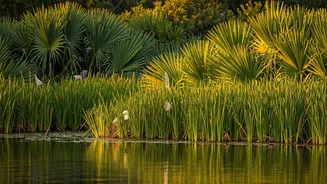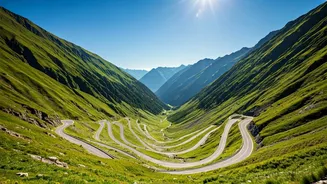Bandhavgarh National Park
Bandhavgarh National Park, nestled in Madhya Pradesh, is a haven for wildlife enthusiasts, particularly those eager to spot the elusive Bengal tiger. It
is believed that this park has one of the highest densities of tigers in India, making it a prime location for tiger sightings. Beyond the majestic tiger, the park is home to a rich biodiversity, including various species of deer, leopards, and a wide array of birdlife. The park's varied topography, from dense forests to grassy meadows, supports a diverse ecosystem. The presence of the historic Bandhavgarh Fort adds a layer of cultural significance, offering visitors a blend of nature and history. The landscape itself is shaped by the Vindhya hills. Exploring this park offers a complete experience, where the thrill of wildlife viewing combines with the beauty of nature and historical echoes.
Jim Corbett National Park
Jim Corbett National Park, situated in Uttarakhand, holds the distinction of being India's oldest national park, established in 1936. It is a legendary destination, celebrated for its tiger population and its pivotal role in Project Tiger. The park is characterized by its diverse terrain, including grasslands, riverine belts, and dense forests, creating a varied habitat that supports a rich range of wildlife. Besides the Bengal tiger, one can find elephants, leopards, and numerous bird species, making it a paradise for birdwatchers. The Ramganga River flows through the park, enhancing its scenic beauty and providing a vital water source for the wildlife. The park's historical significance, coupled with its natural beauty and wildlife richness, makes it a must-visit destination for those seeking a deep connection with nature and wildlife conservation.
Kaziranga National Park
Kaziranga National Park in Assam is recognized globally for its conservation efforts, particularly in protecting the one-horned rhinoceros. This UNESCO World Heritage site is a testament to successful wildlife conservation, with a thriving population of rhinos. The park's landscape is a unique combination of tall elephant grass, wetlands, and dense tropical forests, providing an ideal habitat for a wide array of species. Besides rhinos, Kaziranga is home to elephants, tigers, and a multitude of bird species, making it a crucial biodiversity hotspot. The park is located along the Brahmaputra River, and its unique ecosystem attracts both wildlife and tourists, contributing to its fame. The efforts to protect the rhino and preserve the park's biodiversity make it a remarkable site for environmental conservation.
Ranthambore National Park
Ranthambore National Park in Rajasthan is famed for its majestic tigers and the historical Ranthambore Fort. The park's rugged terrain and dry deciduous forests create a dramatic backdrop for wildlife sightings, making it a favorite destination for photographers and wildlife enthusiasts. The presence of the fort, dating back to the 10th century, provides a unique cultural dimension to the wildlife experience. Visitors often spot tigers roaming freely, adding a sense of thrill. The park's diverse ecosystem supports a variety of species, including leopards, sloth bears, and various bird species. The blend of wildlife, natural beauty, and historical elements makes Ranthambore an unforgettable experience.
Sunderbans National Park
Sunderbans National Park, in West Bengal, forms the world's largest delta and mangrove forest, earning it a spot as a UNESCO World Heritage site. It is most recognized as the home of the Royal Bengal tiger, adapted to living in this unique ecosystem. The dense mangrove forests and intricate waterways create an extraordinary habitat, characterized by its tidal influence and unique plant life. The park's landscape is formed by the confluence of the Ganges, Brahmaputra, and Meghna rivers, which shape the land and provide nutrients for the mangrove ecosystem. Exploring the Sunderbans offers a glimpse into a world where tigers roam through the dense mangroves, making it a thrilling and environmentally significant destination.
Periyar National Park
Periyar National Park in Kerala is known for its biodiversity, featuring a large population of elephants and tigers. The park surrounds the Periyar Lake, which enhances the area's beauty and acts as a water source for the wildlife. The park's landscape is characterized by its lush green forests and rolling hills, offering a scenic backdrop for wildlife viewing. Visitors have opportunities to see elephants, tigers, and various species of deer. The boat rides on Periyar Lake provide unique perspectives of the park's wildlife and vegetation. The park's efforts in conservation, along with its unique natural setting, make it an important destination for environmental tourism.
Kanha National Park
Kanha National Park in Madhya Pradesh is renowned as a key habitat for tigers and the distinctive hard-ground barasingha deer. The park's open grasslands and dense sal forests offer an ideal environment for spotting wildlife, providing opportunities for memorable sightings. The diverse ecosystem includes a variety of flora and fauna, making it a key destination for biodiversity enthusiasts. The park's conservation efforts have played an essential role in safeguarding the population of barasingha deer and other species. The landscapes, coupled with the rich wildlife presence, offer a glimpse into the natural heritage of India, providing visitors with a rewarding exploration experience.
Gir National Park
Gir National Park in Gujarat is the sole home of the Asiatic lion. The park's conservation efforts have successfully helped restore the lion population, turning it into a symbol of pride. The diverse terrain, including scrub forests and grasslands, provides an ideal habitat for these majestic creatures. The park's success in preserving lions highlights its conservation efforts and makes it a critical site for wildlife protection. The efforts in controlling poaching and habitat preservation have contributed to the increase of lion numbers. Visitors can view the lions in their natural habitat, making for an unforgettable experience. The park also houses various other animal species and birdlife.
Nanda Devi National Park
Nanda Devi National Park in Uttarakhand, a UNESCO World Heritage site, is known for its stunning Himalayan landscape. It houses the second-highest mountain in India, Nanda Devi, and is a haven for high-altitude wildlife. The park is characterized by its dramatic alpine meadows, glaciers, and deep gorges. The isolated environment supports a diverse range of plant and animal life, including snow leopards and various bird species. Access to the park is restricted, preserving its pristine beauty. The park's significant natural environment, along with its efforts in conservation, is a unique destination for nature lovers. The awe-inspiring scenery and the unique ecosystem offer unparalleled experiences for those who visit.
Valley of Flowers
The Valley of Flowers National Park, in Uttarakhand, is famous for its vibrant alpine flowers. It is located in the western Himalayas, adding to its appeal. During the monsoon season, the valley transforms into a colorful meadow, with a wide array of flowers in bloom. The park's diversity in flora, along with its unique location and landscape, draws botanists and nature lovers. The experience of walking through the valley, surrounded by various floral species, provides a beautiful and immersive experience. The combination of its serene landscape, unique vegetation, and efforts in conservation, makes it a remarkable destination to visit.











